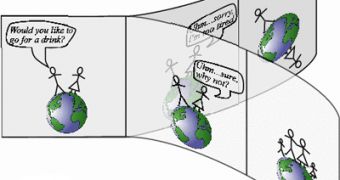Quantum suicide basically states one thing: it is possible that our lives may be depending on the state of a single subatomic particle. Quantum suicide represents a thought experiment proposed by a couple of physicists in the late 1980s in order to make a distinction between the quantum mechanics and the Everett many-worlds interpretation. It is relatively similar to another thought experiment called Schrodinger's cat.
The experiment says that a physicist stands in front of a gun that is triggered by the radioactive decay of an atom. Meaning that the physicist may try to trigger the gun any time he wants, but the bullet will not be fired unless a machine rigged to the gun measures the quantum spin of a sub-atomic particle, which can be up or down. For example, if the detector is set to trigger when it detects the up-spin of a particle, then when the spin will be measured the gun will fire.
This means that the physicist will have a 50-50 chance to life, if he pushes the trigger of the gun, and that he could trigger the gun an infinite amount of time before he dies. Nonetheless, this 50-50 odd gives room to the many-worlds interpretation, as the universe is split in two separate ones, a universe in which the physicist lives and the other where he dies, meaning that, whatever the outcome of the process, the conscious being is immortal.
The live copies of the physicists will continue the experiment until they will cease to exist, but the copies that do not die will notice at some point in time that no matter what they do they never seem to die. Schrodinger's cat thought experiment implies the same basic principle.
Identical situations can be exemplified with nuclear weapons. Let's say that a physicist stands near a nuclear weapon when it detonates. In a parallel universe, the explosion of the weapon will instantly kill the physicist, however quantum mechanics state that there is a chance though that he could escape death through some miraculous way.
If the Copenhagen interpretation of quantum mechanics is wrong and the many-worlds interpretation stating the existence of a parallel universe is correct, then the chances of the physicist to die while triggering the gun increase each time by a factor of 50 percent; meaning that after an amount of time, the chance that the physicist will remain alive drops close to zero, but will never reach zero in order to allow the existence of many-worlds.
The problem is that the many-worlds interpretation of the universe leaves room for debate and experiments identical to the quantum suicide that counter it. Critics argue that the same outcome could be obtained with infinite copies of the same physicist, however with a decrease in copies by 50 percent. Nevertheless, the counter-argument experiment fails to observe that the many-worlds interpretation takes into account the fact that the number of live physicists can be halved for an infinite amount of time without reaching zero.
Furthermore, the quantum suicide thought experiment has no scientific value, as it fails to demonstrate its intended purpose.

 14 DAY TRIAL //
14 DAY TRIAL //